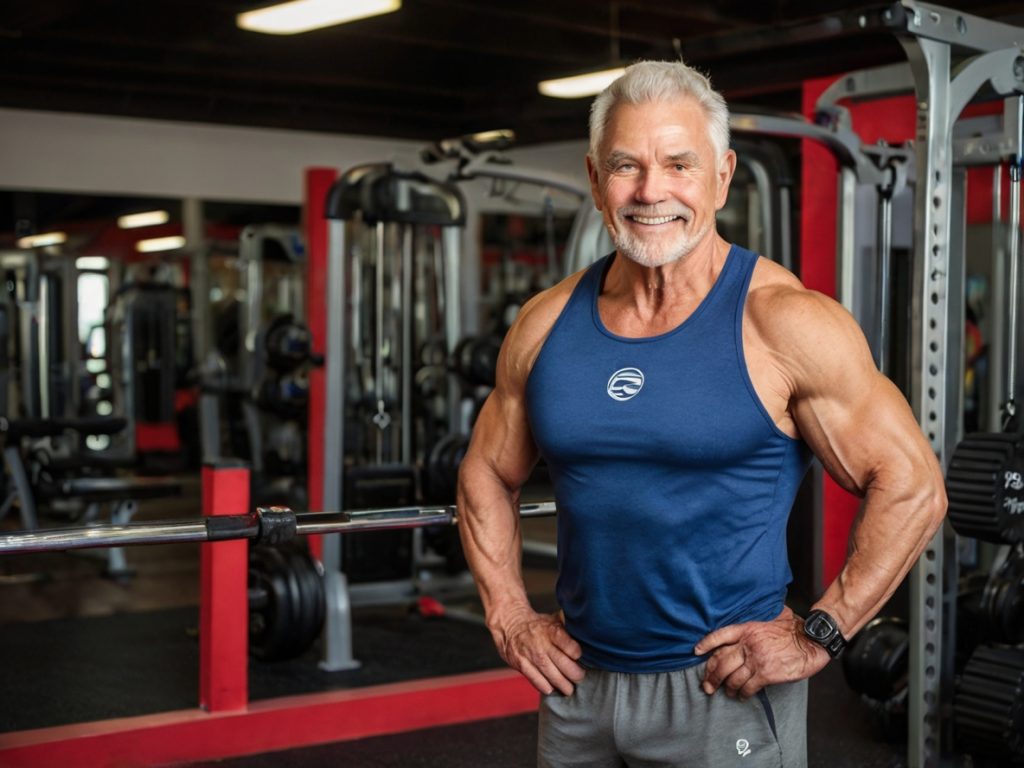Are you ready to discover the secret to maintaining a vibrant and healthy lifestyle as a senior? The answer lies in fitness for seniors. In this comprehensive senior fitness guide, we will explore effective strategies for boosting your health and incorporating exercise routines into your daily life.
Benefits of Fitness for Seniors
Regular exercise and physical activity provide a wide range of benefits for seniors, promoting overall health and well-being. Incorporating senior exercise routines into your daily routine can have a positive impact on various aspects of your life. Let’s explore the specific advantages of fitness for seniors.
Improved Strength and Flexibility
Engaging in regular exercise helps seniors build and maintain strength, improving their ability to perform daily activities and reducing the risk of falls. Senior exercise routines that incorporate strength training exercises, such as lifting weights or using resistance bands, can help increase muscle mass and improve balance. Flexibility exercises, such as yoga or stretching, enhance joint mobility and range of motion, making it easier to perform daily tasks and enjoy activities.
Enhanced Cardiovascular Health
Senior health and fitness go hand in hand when it comes to cardiovascular health. Regular aerobic exercise, such as walking, swimming, or cycling, can help seniors improve their heart and lung function. This can lead to a reduced risk of cardiovascular diseases, like heart disease and stroke. Aerobic exercises also help maintain a healthy weight and lower blood pressure, contributing to overall well-being.
Positive Mental Well-being
Exercise has a significant impact on mental health, and seniors are no exception. Engaging in physical activity releases endorphins, chemicals in the brain that promote feelings of happiness and reduce stress and anxiety. Regular exercise can also improve cognitive function and memory, promoting brain health in seniors. By incorporating senior exercise routines into their lives, seniors can experience improved mood, enhanced mental clarity, and reduced risk of depression.
Reduced Risk of Chronic Diseases
Elderly fitness plays a crucial role in reducing the risk of chronic diseases that often come with age. Regular exercise has been shown to decrease the risk of conditions such as diabetes, osteoporosis, and certain types of cancer. By maintaining an active lifestyle and incorporating senior exercise routines, seniors can strengthen their immune system, improve their overall health, and reduce their risk of developing these chronic conditions.
Summary of Benefits
| Benefits of Fitness for Seniors |
|---|
| Improved strength and flexibility |
| Enhanced cardiovascular health |
| Positive mental well-being |
| Reduced risk of chronic diseases |
Senior Strength Training: Building Stronger Bodies
As we age, maintaining muscle mass, bone density, and overall function becomes increasingly important for seniors. One effective method to achieve these goals is through senior strength training. This type of exercise focuses on resistance and weight-bearing activities that help build strength, improve balance, and enhance overall physical performance.
The Benefits of Senior Strength Training
Senior strength training offers a multitude of benefits that contribute to a better quality of life. Let’s explore some of these advantages:
- Increased Muscle Strength: Engaging in regular strength training exercises helps seniors strengthen their muscles, enhancing their ability to perform daily activities with ease.
- Improved Bone Density: Strength training stimulates bone growth and helps prevent age-related bone loss, reducing the risk of osteoporosis and fractures.
- Better Balance and Stability: By enhancing muscle strength, seniors can improve their balance and stability, reducing the risk of falls and injuries.
- Enhanced Metabolism: Strength training exercises increase muscle mass, which can boost metabolism and aid in maintaining a healthy weight.
- Improved Joint Health: Strengthening the muscles around joints can alleviate pain and discomfort associated with conditions such as arthritis.
To experience these benefits, it’s essential to engage in safe and effective exercises specifically designed for seniors.
Safe and Effective Exercises
When it comes to senior strength training, it’s crucial to choose exercises that are safe for your age and fitness level. Here are a few examples:
| Exercise | Description |
|---|---|
| Squats | A functional exercise that strengthens the lower body muscles. |
| Resistance Band Rows | A seated or standing exercise that targets the back muscles. |
| Wall Push-Ups | A modified version of push-ups that strengthens the chest and arm muscles. |
| Step-Ups | An exercise that targets the lower body muscles and improves balance. |
| Bicep Curls | An exercise that targets the arm muscles and improves upper body strength. |
Remember to start with light weights or resistance bands and gradually increase the intensity as you build strength and confidence. It’s important to consult with a healthcare professional or certified fitness trainer before starting any new exercise program.
Creating a Senior Strength Training Program
To create a personalized senior strength training program that suits your abilities and goals, consider the following:
- Set specific goals for strength improvement, such as increasing the amount of weight lifted or the number of repetitions performed.
- Include a variety of exercises that target different muscle groups for a well-rounded workout.
- Plan for at least two days of strength training per week, allowing for adequate rest days in between sessions.
- Gradually increase the intensity and challenge of the exercises over time to continue making progress.
By incorporating senior strength training into your fitness routine, you can improve muscle strength, bone density, and overall function, leading to a stronger, healthier body in your senior years.
Customizing Exercise for Older Adults
As we age, our bodies experience various changes that require adjustments to our exercise routines. It becomes crucial to customize and modify exercises to meet the unique needs and abilities of older adults. In this section, we will provide valuable tips and insights on how to adapt your senior fitness routine to maintain an active lifestyle.
1. Cardiovascular Exercises
Incorporating cardiovascular exercises into your senior exercise routine helps improve heart health, enhance endurance, and boost overall well-being. Here are some cardiovascular activities suited for older adults:
- Walking: Engage in brisk walks or join a walking group in your neighborhood.
- Swimming: Take advantage of low-impact aquatic exercises that are gentle on joints.
- Cycling: Consider using a stationary bike or participate in outdoor cycling on flat terrain.
2. Balance Training
With age, balance and stability can decline, increasing the risk of falls. To address this, incorporate balance exercises into your routine to enhance coordination and reduce the risk of accidents. Here are some recommended balance exercises:
- Single-leg stands: Stand on one leg while maintaining stability and gradually increase the duration.
- Heel-to-toe walk: Practice walking in a straight line, placing the heel of your front foot directly in front of the toes of your back foot.
- Yoga or tai chi: These mind-body practices focus on balance, flexibility, and body awareness.
3. Flexibility Exercises
Flexibility exercises help maintain a full range of motion, improve posture, and alleviate muscle stiffness. Incorporate these exercises into your routine:
- Stretching: Perform gentle stretches for major muscle groups, holding each stretch for 15-30 seconds.
- Yoga: Practice yoga poses that promote flexibility, such as seated forward bends and gentle spinal twists.
- Pilates: Engage in low-impact exercises that improve flexibility and core strength.
By incorporating these customized exercises into your senior fitness routine, you can improve cardiovascular health, prevent falls, and maintain flexibility. Remember, it’s always important to consult with a healthcare professional or a certified fitness instructor before starting any new exercise program.
| Exercise Benefits | Exercise Types |
|---|---|
| Improves cardiovascular health | Walking, swimming, cycling |
| Enhances balance and stability | Single-leg stands, heel-to-toe walk, yoga, tai chi |
| Increases flexibility and range of motion | Stretching, yoga, Pilates |
Creating a Senior Wellness Program
A holistic approach to senior fitness goes beyond exercise alone. It encompasses various lifestyle factors that contribute to overall health and well-being. When developing a senior wellness program, consider incorporating the following components:
Nutrition
Proper nutrition is vital for seniors to maintain optimal health and support their fitness goals. A well-balanced diet rich in nutrients provides essential fuel for the body, ensuring seniors have the energy they need to stay active. Incorporate a variety of fruits, vegetables, whole grains, lean proteins, and healthy fats into meals. Consult with a registered dietitian for personalized guidance on senior nutrition.
Stress Management
Managing stress is crucial for seniors, as chronic stress can negatively impact physical and mental health. Encourage seniors to find effective stress reduction techniques that work for them, such as meditation, deep breathing exercises, engaging in hobbies, or spending time with loved ones. Developing healthy coping mechanisms can help seniors reduce stress levels and improve overall well-being.
Sleep Hygiene
Adequate sleep is essential for seniors to support their overall health and fitness. Poor sleep quality or insufficient sleep can affect cognitive function, mood, energy levels, and the body’s ability to recover from exercise. Encourage seniors to maintain a regular sleep schedule, create a comfortable sleep environment, and engage in relaxing activities before bed to promote better sleep hygiene.
Social Connections
Seniors who maintain strong social connections often experience improved mental and emotional well-being. Encourage seniors to actively engage in activities that promote social interactions, such as joining community groups, participating in senior fitness classes, or volunteering. These connections can provide a sense of belonging, reduce feelings of loneliness, and contribute to overall happiness.
By integrating these components into a senior wellness program, individuals can enhance their overall health and well-being in conjunction with physical exercise. The synergy of nutrition, stress management, sleep hygiene, and social connections complements fitness for seniors and promotes a comprehensive approach to senior wellness.
Overcoming Challenges and Staying Motivated
Starting or maintaining a fitness routine can be challenging for seniors, but it’s important to remember that it’s never too late to prioritize your health and well-being. In this section, we will discuss common obstacles that seniors may face when it comes to exercise and provide practical strategies to overcome them.
1. Mobility Issues
As we age, mobility may become more challenging due to joint stiffness, decreased muscle strength, or chronic conditions such as arthritis. However, it’s crucial to find exercises that cater to your abilities and range of motion. Low-impact activities like walking, swimming, or chair exercises can help improve mobility while reducing the risk of injury.
2. Chronic Pain
Chronic pain can be a significant barrier to staying active, but it doesn’t mean giving up on exercise entirely. Speak with your healthcare provider or a qualified fitness professional to explore suitable exercises that can work around your pain. Gentle stretching, yoga, or water aerobics are often beneficial for managing pain while improving strength and flexibility.
3. Motivation
Staying motivated can be a challenge, regardless of age. To maintain your motivation, set realistic goals, and celebrate each achievement along the way. Consider finding a workout buddy or joining group exercise classes tailored for seniors to stay engaged and accountable. Additionally, vary your exercise routine to keep it interesting and enjoyable.
Remember, consistency is key to reaping the full benefits of senior exercise routines. Push through the challenges and stay motivated by focusing on the positive impact exercise has on your overall health and well-being.
Conclusion
Incorporating fitness into your senior years is essential for maintaining a vibrant and healthy lifestyle. By following the strategies outlined in this senior fitness guide, you can enhance your well-being, improve functional abilities, and enjoy an active and fulfilling life as a senior.
Regular exercise and physical activity offer numerous benefits for seniors, including improved strength, flexibility, cardiovascular health, and mental well-being. Strength training plays a crucial role in maintaining muscle mass, bone density, and overall function. Customizing exercise routines to meet the unique needs and abilities of older adults is important for maximizing the benefits and minimizing risks.
Additionally, a holistic approach to senior wellness goes beyond exercise. Nutrition, stress management, sleep hygiene, and social connections also contribute to overall health and well-being. By incorporating these components into your senior wellness program, you can optimize your quality of life as a senior.
While challenges may arise, such as mobility issues, chronic pain, or lack of motivation, there are practical strategies to overcome these obstacles. By staying motivated and persevering through the challenges, you can maintain a consistent fitness routine and continue reaping the benefits of an active lifestyle into your senior years.
FAQ
Q: What are the benefits of fitness for seniors?
A: Fitness for seniors offers numerous advantages, including improved strength, flexibility, cardiovascular health, mental well-being, and reduced risk of chronic diseases.
Q: Why is senior strength training important?
A: Senior strength training helps maintain muscle mass, bone density, and overall function. It is crucial for older adults to preserve their strength and independence.
Q: How can I customize exercise routines for older adults?
A: To customize exercise routines for older adults, it is important to consider their unique needs and abilities. Incorporate cardiovascular exercises, balance training, and flexibility exercises into their fitness routine.
Q: What does a senior wellness program entail?
A: A senior wellness program encompasses exercise, nutrition, stress management, sleep hygiene, and social connections. Taking a holistic approach to senior fitness is essential for overall health and well-being.
Q: How can I overcome challenges and stay motivated as a senior?
A: Common challenges for seniors include mobility issues, chronic pain, and motivation. By adopting practical strategies and seeking support, you can overcome these obstacles and stay motivated on your fitness journey.







